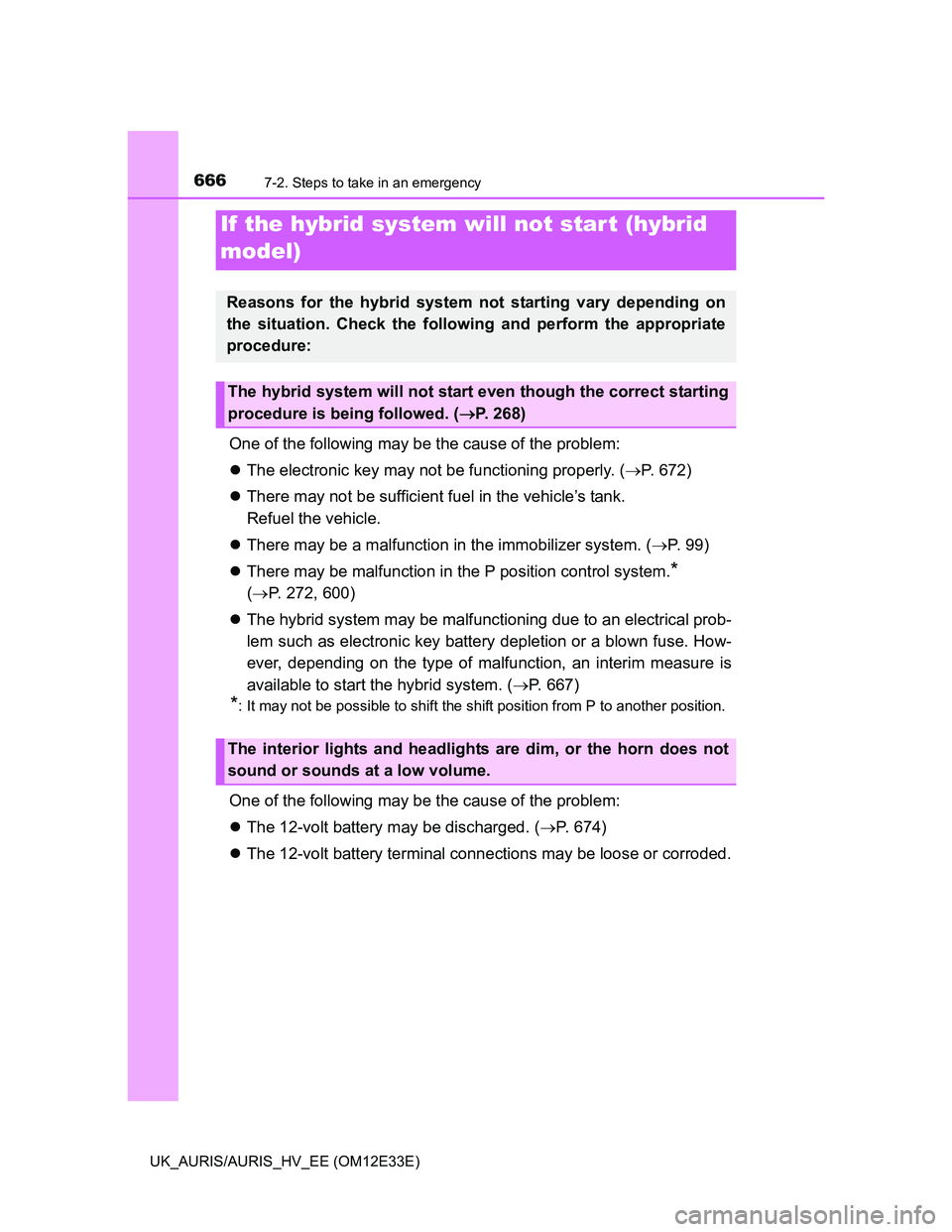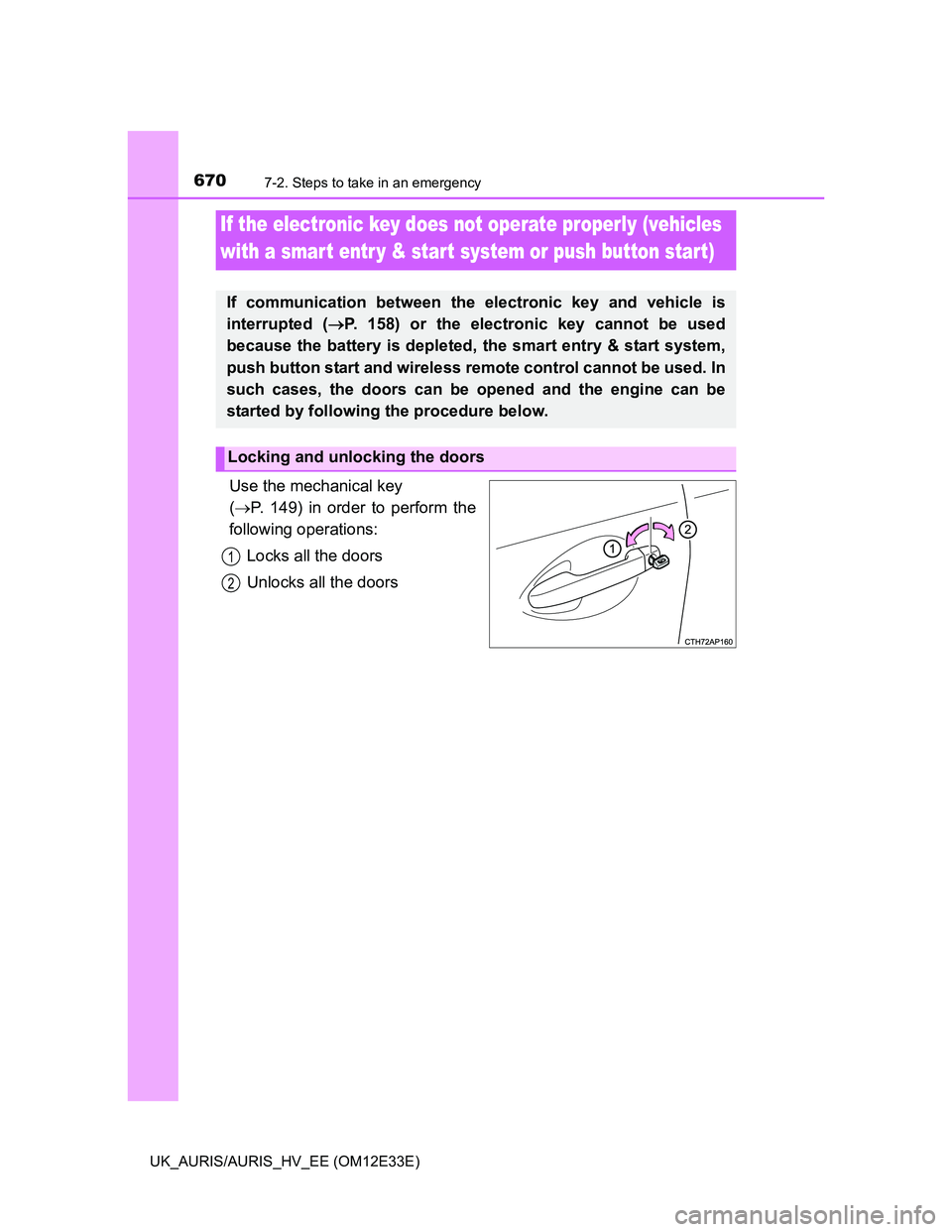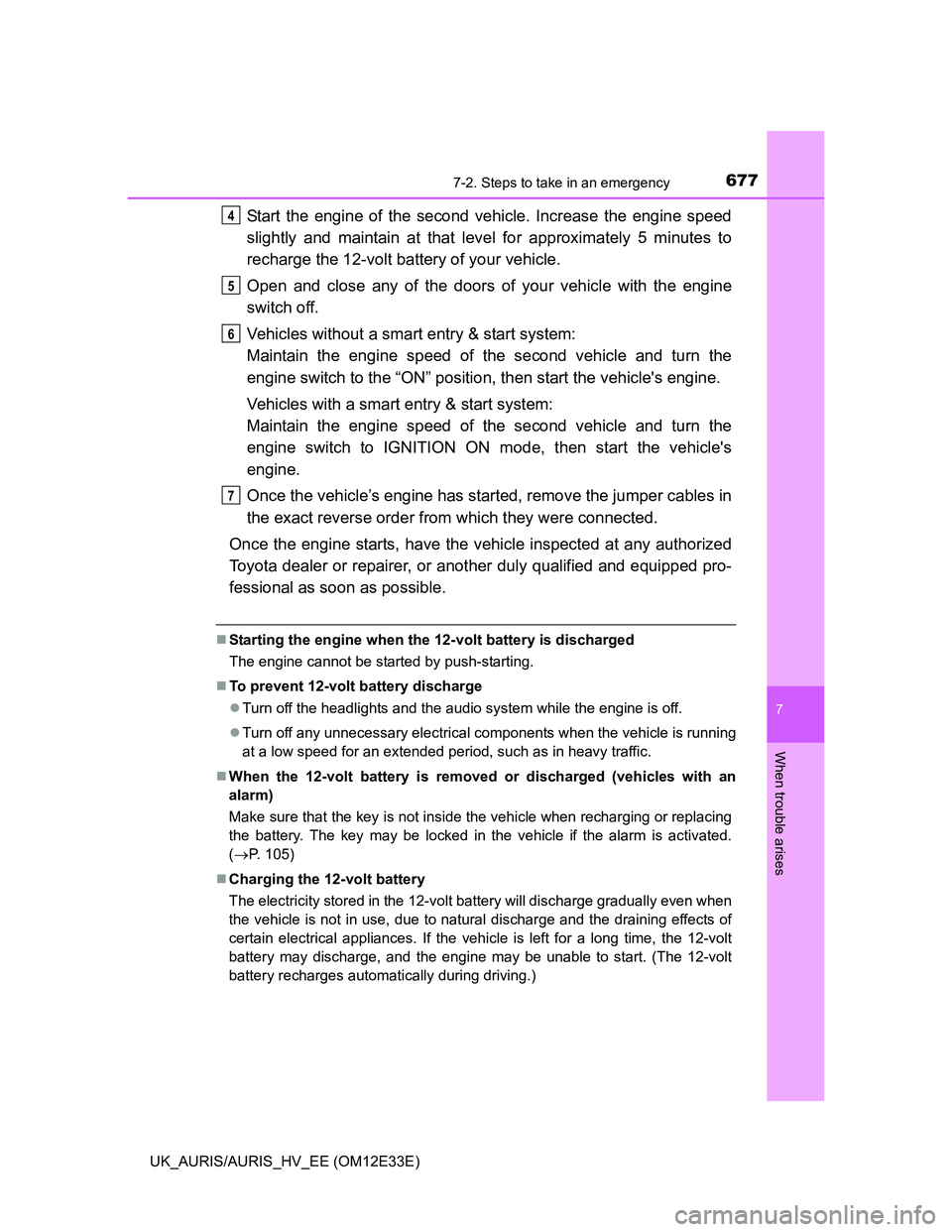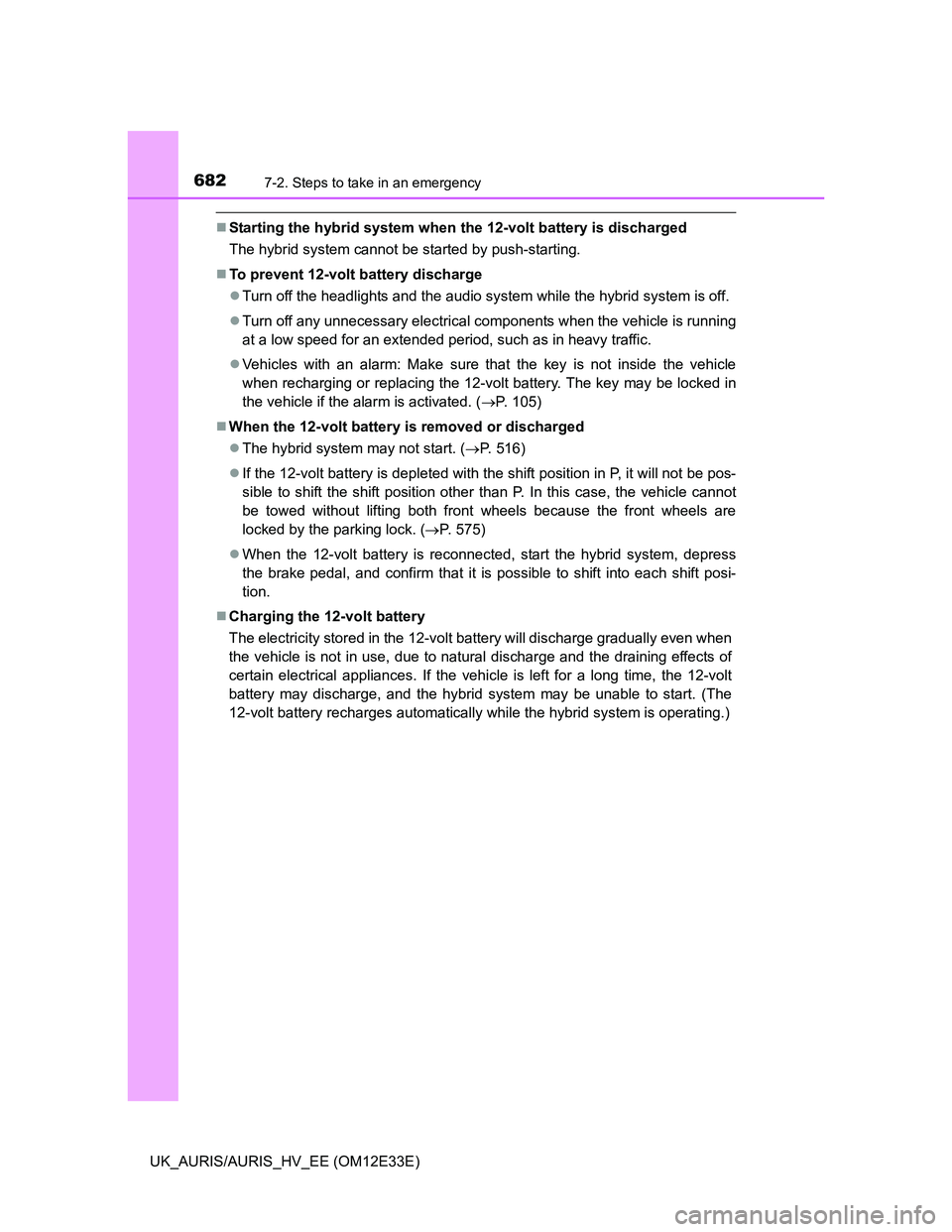2012 TOYOTA AURIS key
[x] Cancel search: keyPage 668 of 750

6667-2. Steps to take in an emergency
UK_AURIS/AURIS_HV_EE (OM12E33E)
One of the following may be the cause of the problem:
The electronic key may not be functioning properly. (P. 672)
There may not be sufficient fuel in the vehicle’s tank.
Refuel the vehicle.
There may be a malfunction in the immobilizer system. (P. 9 9 )
There may be malfunction in the P position control system.
*
(P. 272, 600)
The hybrid system may be malfunctioning due to an electrical prob-
lem such as electronic key battery depletion or a blown fuse. How-
ever, depending on the type of malfunction, an interim measure is
available to start the hybrid system. (P. 667)
*: It may not be possible to shift the shift position from P to another position.
One of the following may be the cause of the problem:
The 12-volt battery may be discharged. (P. 674)
The 12-volt battery terminal connections may be loose or corroded.
If the hybrid system will not star t (hybrid
model)
Reasons for the hybrid system not starting vary depending on
the situation. Check the following and perform the appropriate
procedure:
The hybrid system will not start even though the correct starting
procedure is being followed. (P. 268)
The interior lights and headlights are dim, or the horn does not
sound or sounds at a low volume.
Page 672 of 750

6707-2. Steps to take in an emergency
UK_AURIS/AURIS_HV_EE (OM12E33E)
Use the mechanical key
(P. 149) in order to perform the
following operations:
Locks all the doors
Unlocks all the doors
If the electronic key does not operate properly (vehicles
with a smart entr y & start system or push button start)
If communication between the electronic key and vehicle is
interrupted (P. 158) or the electronic key cannot be used
because the battery is depleted, the smart entry & start system,
push button start and wireless remote control cannot be used. In
such cases, the doors can be opened and the engine can be
started by following the procedure below.
Locking and unlocking the doors
1
2
Page 673 of 750

6717-2. Steps to take in an emergency
UK_AURIS/AURIS_HV_EE (OM12E33E)
7
When trouble arises
Multidrive: Ensure that the shift lever is in P and depress the brake
pedal.
Multi-mode manual transmission: Ensure that the shift lever is in N
and depress the brake pedal.
Manual transmission: Shift the shift lever to N and depress the
clutch pedal.
Touch the Toyota emblem side
of the electronic key to the
engine switch.
The engine switch will turn to IGNI-
TION ON mode.
When the smart entry & start sys-
tem is deactivated in customization
setting, the engine switch will turn
to ACCESSORY mode.
Vehicles without a multi-information display: Firmly depress the
brake pedal (Multidrive or multi-mode manual transmission) or
clutch pedal (manual transmission) and check that the smart entry
& start system indicator light (green) turns on.
Vehicles with a multi-information display: Firmly depress the brake
pedal (Multidrive or multi-mode manual transmission) or clutch
pedal (manual transmission) and check that is shown on the
multi-information display.
Press the engine switch.
In the event that the engine still cannot be started, contact any autho-
rized Toyota dealer or repairer, or another duly qualified and equipped
professional.
Starting the engine (except hybrid model)
1
2
3
4
Page 674 of 750

6727-2. Steps to take in an emergency
UK_AURIS/AURIS_HV_EE (OM12E33E)
Depress the brake pedal.
Touch the Toyota emblem side
of the electronic key to the
power switch.
The power switch will turn to ON
mode.
When the smart entry & start sys-
tem or push button start is deacti-
vated in customization setting, the
power switch will turn to ACCES-
SORY mode.
Firmly depress the brake pedal and check that is shown on
the multi-information display.
Press the power switch.
In the event that the hybrid system still cannot be started, contact any
authorized Toyota dealer or repairer, or another duly qualified and
equipped professional.
Stopping the engine (except hybrid model)
Shift the shift lever to P (Multidrive) or N (manual transmission and multi-
mode manual transmission) and press the engine switch as you normally do
when stopping the engine.
Stopping the hybrid system (hybrid model)
Push the P position switch and press the power switch as you normally do
when stopping the hybrid system.
Replacing the key battery
As the above procedure is a temporary measure, it is recommended that the
electronic key battery be replaced immediately when the battery is depleted.
(P. 529)
Alarm (if equipped)
Using the mechanical key to lock the doors will not set the alarm system.
If a door is unlocked using the mechanical key when the alarm system is set,
the alarm may be triggered.
Starting the hybrid system (hybrid model)
1
2
3
4
Page 675 of 750

6737-2. Steps to take in an emergency
UK_AURIS/AURIS_HV_EE (OM12E33E)
7
When trouble arises
Changing engine switch modes (except hybrid model)
Release the brake pedal (Multidrive and multi-mode manual transmission) or
clutch pedal (manual transmission) and press the engine switch in step
above.
The engine does not start and modes will be changed each time the switch is
pressed. (P. 261)
Changing power switch modes (hybrid model)
Release the brake pedal and press the power switch in step above.
The hybrid system does not start and modes will be changed each time the
switch is pressed. (P. 261)
When the electronic key does not work properly
Make sure that the smart entry & start system and push button start has not
been deactivated in the customization setting. If it is off, turn the function on.
(Customizable features P. 719)
Check if battery-saving mode is set. If it is set, cancel the function.
(P. 157)
3
3
Page 679 of 750

6777-2. Steps to take in an emergency
UK_AURIS/AURIS_HV_EE (OM12E33E)
7
When trouble arises
Start the engine of the second vehicle. Increase the engine speed
slightly and maintain at that level for approximately 5 minutes to
recharge the 12-volt battery of your vehicle.
Open and close any of the doors of your vehicle with the engine
switch off.
Vehicles without a smart entry & start system:
Maintain the engine speed of the second vehicle and turn the
engine switch to the “ON” position, then start the vehicle's engine.
Vehicles with a smart entry & start system:
Maintain the engine speed of the second vehicle and turn the
engine switch to IGNITION ON mode, then start the vehicle's
engine.
Once the vehicle’s engine has started, remove the jumper cables in
the exact reverse order from which they were connected.
Once the engine starts, have the vehicle inspected at any authorized
Toyota dealer or repairer, or another duly qualified and equipped pro-
fessional as soon as possible.
Starting the engine when the 12-volt battery is discharged
The engine cannot be started by push-starting.
To prevent 12-volt battery discharge
Turn off the headlights and the audio system while the engine is off.
Turn off any unnecessary electrical components when the vehicle is running
at a low speed for an extended period, such as in heavy traffic.
When the 12-volt battery is removed or discharged (vehicles with an
alarm)
Make sure that the key is not inside the vehicle when recharging or replacing
the battery. The key may be locked in the vehicle if the alarm is activated.
(P. 105)
Charging the 12-volt battery
The electricity stored in the 12-volt battery will discharge gradually even when
the vehicle is not in use, due to natural discharge and the draining effects of
certain electrical appliances. If the vehicle is left for a long time, the 12-volt
battery may discharge, and the engine may be unable to start. (The 12-volt
battery recharges automatically during driving.)
4
5
6
7
Page 680 of 750

6787-2. Steps to take in an emergency
UK_AURIS/AURIS_HV_EE (OM12E33E)When recharging or replacing the 12-volt battery
Vehicles with an alarm: Make sure the key is not inside the vehicle when
recharging or replacing the 12-volt battery to prevent the doors from being
locked with the key left inside the vehicle when the alarm operates.
Vehicles with a smart entry & start system: In some cases, it may not be
possible to unlock the doors using the smart entry & start system when the
battery is discharged. Use the wireless remote control or the mechanical
key to lock or unlock the doors.
The engine may not start on the first attempt after the 12-volt battery has
recharged but will start normally after the second attempt. This is not a mal-
function.
The engine switch mode is memorized by the vehicle. When the 12-volt bat-
tery is reconnected, the system will return to the mode it was in before the
12-volt battery was discharged. Before disconnecting the 12-volt battery,
turn the engine switch off.
If you are unsure what mode the engine switch was in before the 12-volt
battery discharged, be especially careful when reconnecting the 12-volt bat-
tery.
CAUTION
Avoiding battery fires or explosions
Observe the following precautions to prevent accidentally igniting the flam-
mable gas that may be emitted from the 12-volt battery:
Make sure each jumper cable is connected to the correct terminal and that
it is not unintentionally in contact with any other than the intended terminal.
Do not allow the other end of the jumper cable connected to the “+” termi-
nal to come into contact with any other parts or metal surfaces in the area,
such as brackets or unpainted metal.
Do not allow the + and - clamps of the jumper cables to come into contact
with each other.
Do not smoke, use matches, cigarette lighters or allow open flame near
the 12-volt battery.
Page 684 of 750

6827-2. Steps to take in an emergency
UK_AURIS/AURIS_HV_EE (OM12E33E)
Starting the hybrid system when the 12-volt battery is discharged
The hybrid system cannot be started by push-starting.
To prevent 12-volt battery discharge
Turn off the headlights and the audio system while the hybrid system is off.
Turn off any unnecessary electrical components when the vehicle is running
at a low speed for an extended period, such as in heavy traffic.
Vehicles with an alarm: Make sure that the key is not inside the vehicle
when recharging or replacing the 12-volt battery. The key may be locked in
the vehicle if the alarm is activated. (P. 105)
When the 12-volt battery is removed or discharged
The hybrid system may not start. (P. 516)
If the 12-volt battery is depleted with the shift position in P, it will not be pos-
sible to shift the shift position other than P. In this case, the vehicle cannot
be towed without lifting both front wheels because the front wheels are
locked by the parking lock. (P. 575)
When the 12-volt battery is reconnected, start the hybrid system, depress
the brake pedal, and confirm that it is possible to shift into each shift posi-
tion.
Charging the 12-volt battery
The electricity stored in the 12-volt battery will discharge gradually even when
the vehicle is not in use, due to natural discharge and the draining effects of
certain electrical appliances. If the vehicle is left for a long time, the 12-volt
battery may discharge, and the hybrid system may be unable to start. (The
12-volt battery recharges automatically while the hybrid system is operating.)